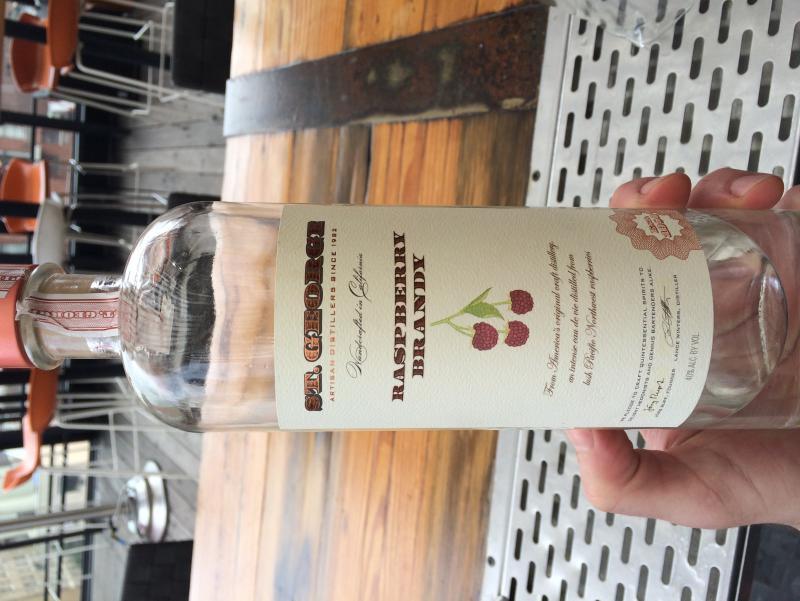-
Posts
900 -
Joined
-
Last visited
Content Type
Profiles
Forums
Store
Help Articles
Posts posted by Rafa
-
-
Finished The Dead Rabbit's book last night. It's good. You won't find any of the sections on tecnique, ingredients, running a bar, principles of crafting cocktails, &c that you'll find in more general interest cocktail tomes like the Death & Co or PDT books. What you'll get instead is recipes, and lots of them, all of them original, all of them elaborate and stylistically distinct from much else of what's going on in US bars. Jack McGarry's rococo style is right up my alley, and if you don't mind searching out specialized ingredients (eaux de vie, maidenfern) or making your own (so many tinctures) there's a lot of great drinks to make here. The only other substantial content in the book is an extensive self-mythologizing biography of the principals, which is... probably less interesting, to the general reader.
-
 2
2
-
-
Very much enjoying the new Dead Rabbit cocktail book. DR is still ahead of the game in a lot of ways—their use of tinctures, their incorporation of seasonal and savory herbs outside the California "salad in a glass" context, the rich flavorsome balance of their drinks. That said, if you think the tone of the Death & Co book skewed self-congratulatory (and I do)... ooh boy. Sean Muldoon didn't name his company The Best Bar In The World LLC for nothing.
-
 1
1
-
-
I tried a bit of the new 70-proof Cynar yesterday. It tastes, well, like Cynar, with more forward alcohol and a bit less perceptible sweetness (while the proof went up, the rest of the recipe, including the amount of sugar, is untouched, the Campari rep told me). It will make a good base for drinks, but I suspect most of it will end up going into shots.
-
 2
2
-
-
Yeah, Luca is unbelievable.
-
 1
1
-
-
Great garnish.
-
 2
2
-
-
hello,
is there any book which teachs to do all basics such as speed pouring, rolling... elegantly as we can see in cocktail bars. I know that practice is the only method but maybe there is a book or maybe videos which explain subtle details. I am not talking about flair bartending, something subtler
thank you
That kind of stuff comes with comfort and practice. The bartenders you see do it have been picking up bottles and pouring drinks hundreds of times a shift for months or years. I'm not saying any of these little tricks take that long to learn--they don't--but they're born of a comfort with and a joy in one's tools and an awareness that as a working bartender you're a performer, and part of your job is to give guests a show while they wait for their drinks.
So I would focus on getting good on the basics, finding a consistent mise-en-place that works for you, and just banging drinks out. You'll find your style.
As Chris mentioned, the Death & Co book gets into technique, while Morgenthaler's book focuses heavily on it. I would also look at videos on the Small Screen Network, particularly those by working bartenders, like Jamie Boudreau, Charlotte Voisey, and Morgenthaler himself.
-
 1
1
-
-
-
-
I don't find Fernet and ginger boring, though it was ubiquitous for a time. They bring out good things in each other. Campari + grapefruit makes grapefruit more interesting and Campari less detectable.
Cynar and apple brandy.
Aged agricole and lemon peel (a rum sour with Clement VSOP, Petite Canne syrup, lemon juice, and lemon peel shaken in is divine).
Peychaud's and strawberry.
-
 3
3
-
-

The Smooth Ambler rum is a blend of 1990 Appleton and 1980s Monymusk bottled at 90 proof, purchased at Astor Wines. The Alessio Vermouth Chinato was a gift for participating in Cure's takeover of our bar this week. The 28 year old Armagnac is an early birthday present to myself to be opened in a couple of months when I turn 28. The penguins are cold brew coffee.
-
 3
3
-
-
Could you please use these in a sentence...I mean in a drink? My refrigerator holds a large volume of each.
So sad that grapefruit are out of season.
There's the ca. 1908 Bacardi Cocktail from Boothby, which calls for 2:1 white Cuban rum (though I prefer more aged) to sweet vermouth and a barspoon or two of pineapple syrup. (Not to be confused with the many other drinks named Bacardi Cocktail through the years.)
I also like a cobbler-style drink of Carpano, pineapple gomme, and crushed ice, maybe fortified a bit by a spirit of your choice or bittered to taste.
Edit: since Chartreuse loves pineapple, a Bijou riff might be worth a try, though one'd have to get the sweetness under control.
-
A personal favorite trick weapon: smokey spirits (mezcal, Islay) and pear eau de vie. Similarly, lush or spicy aged spirits (bourbons, Speysides, Armagnacs) and pear eau de vie. In fact, matching a complex base spirit to a small amount of a complementary eau de vie (pisco and apricot brandy, Armagnac and plum) is a great way to add depth to a drink while giving it an appealing aromatic top note.
Irish whiskey and oude genever.
Jamaican rum and port.
Strawberry and Maraschino.
We could go on.
-
 2
2
-
-
Cinnamon and grapefruit.
Cinnamon and fino sherry.
Agave and sherry.
Aquavit and agave.
Gin and aquavit.
Citrus and gin.
Ginger and citrus.
Singani and orange flower water.
Carpano Antica and pineapple gomme.
Benedictine and chocolate.
Chartreuse and chocolate.
Great topic. If I remember correctly, the Death & Co book has a section on this.
-
 4
4
-
-
(it's a craft version of an absurd drink that was an inside joke involving a couple of TV shows).
I should say that red wine and tonic (TV's Old Spanish, sans olive) actually isn't half bad, given the right red wine and a certain level of inebriation.
Manzanilla and tonic is one of my go-tos, and I add Cynar to everything.
-
A rep for New England Distilling, a 4-person operation out of Maine, tasted me on their full product line: a gin (malty, complex, crisp, reminiscent of Green Hat out of DC), a rye (complexly malty and beer-ish, but still far too young), and a rum. The rum took me by surprise: I wasn't expecting much, certainly not a rich nose full of toffee, caramel, and roasted sugar matched to a lush, dry, whiskyish palate. They slow-ferment Brazilian molasses at low temperature with brewer's yeast for about a week, and distill slowly in copper pot stills. The rep described it as colonial-style, which I took to mean Medford. It's not mind-blowing; it's just good, solid, honest, un-sugared rum, which is rare enough on the market, let alone from the continental US. Promising stuff; I hope they release more, and that other US distilleries follow suit.
-
 3
3
-
-
I love Owney's rum. I wish we could get it in San Diego!
It's an excellent product. Makes a great Daiquiri.
-
Rooftop Queen's Park.

-
 4
4
-
-
Two Mondays ago we at roof at Park South paid our respects with a round of Daiquiris. Owney's rum, lime, sugar. (Not my arm.)

-
 2
2
-
-
Of the commercial spiced rums, Chairman's Reserve and Don Q are my favorites. You can make a very good one by employing your favorite recipe for homemade falernum, diluting to taste, and stopping short of adding sugar.
-
Browsing through the new version of Wondrich's Imbibe reminded me of one of my favorite classic families, the "Improved {base spirit of choice} Cocktail":
2oz base spirit, 1/2 tsp simple, 1/4 tsp Maraschino, dash absinthe, 2 dashes aromatic bitters, expressed lemon.
Last night I made one with Hacienda De Chihuahua Sotol anejo and it was quite lovely.
A nice aperitif with a dry sherry as the base. Just omit the simple.
-
 2
2
-
-
You are right of course. And I should know since I attended Martin Cate's seminar at Tiki Oasis last year that dealt with this exact topic. Long day!

No worries, it's not in the, uh, spirit of rum to get caught up on the small details when one could instead be drinking more Mai Tais.
-
Or just use Denizen Merchant's Reserve which is already a mix of Jamaican (like the Appleton) and aged agricole (like the Clement). Developed in collaboration with Martin Cate, with Mai Tais in mind.
The Martinique rum used in the Merchant's Reserve is molasses-based--it's a rare rhum industriel from Martinique. Martin Cate's research led him to believe that the style of Martinician rum Vic used for his Mai Tai blend was derived from molasses, not cane juice. (In this he departs from Berry). Regardless, an agricole is delicious in a Mai Tai--with good rums and good orgeat, it's hard to go wrong.
-
How's the Lahi?
-
How's the HSE Islay finish?





"Death & Co: Modern Classic Cocktails"
in Spirits & Cocktails
Posted
I always love your glassware, frog.